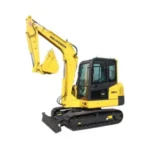Introduction

In the realm of construction, pile drivers stand as stalwart workhorses, tasked with driving piles deep into the ground to provide a solid foundation for structures. These powerful machines come in various forms, each tailored to specific applications and soil conditions. Whether you’re a seasoned contractor or a curious homeowner, this comprehensive guide delves into the world of pile driver equipment, equipping you with the knowledge to make informed decisions and ensure successful projects.
Understanding the Types of Pile Drivers: A Diverse Landscape
The world of pile drivers encompasses a diverse array of equipment, each designed to address different challenges and suit various applications:
- Impact Hammers: These traditional pile drivers utilize a heavy weight repeatedly striking the top of the pile to drive it into the ground. Impact hammers are known for their efficiency and power, making them suitable for driving piles through hard soils and dense materials.
- Vibratory Hammers: Unlike impact hammers, vibratory hammers rely on a combination of vibration and downward force to drive piles. The vibrations create liquefaction in the soil, reducing friction and allowing the pile to penetrate more easily. Vibratory hammers are particularly effective in sandy and cohesive soils.
- Hydraulic Hammers: These modern pile drivers employ a hydraulic cylinder to generate a rapid, high-force impact, driving the pile into the ground with precision. Hydraulic hammers offer greater control and reduced noise compared to impact hammers, making them suitable for urban environments and sensitive areas.
- Diesel Hammers: Powered by diesel engines, diesel hammers deliver powerful blows to drive piles through challenging soil conditions. Their rugged design and high impact energy make them suitable for large-scale construction projects.
Factors to Consider When Choosing Pile Driver Equipment
Selecting the right pile driver equipment for your project requires careful consideration of several factors:
- Soil Conditions: The type of soil plays a crucial role in determining the suitable pile driver. Impact hammers are effective in hard soils, while vibratory hammers excel in sandy soils, and hydraulic hammers are suitable for a wider range of soil conditions.
- Pile Type: The type of pile being driven also influences the choice of pile driver. Impact hammers are commonly used for driving steel piles, while vibratory hammers can handle various pile types, including steel, concrete, and timber.
- Noise Restrictions: In urban areas or noise-sensitive environments, hydraulic hammers may be preferred due to their lower noise levels compared to impact and diesel hammers.
- Project Budget: Pile drivers vary in cost depending on their type, size, and capabilities. Consider your project budget and the required performance when making your selection.
Comparison of Popular Pile Driver Models: A Glimpse into Options
To help you narrow down your choices, here’s a comparison of three popular pile driver models:
| Fonctionnalité | APE Model 2250 Impact Hammer | Maxpower ME600.9P | PTC Hydraulic Hammer HH-75 |
|---|---|---|---|
| Fabricant | American Piledriving Equipment | Maxpower Piling Equipment | PTC Piling Technologies |
| Power Source | Diesel | Hydraulique | Hydraulique |
| Driving Mechanism | Impact | Impact | Hydraulic Impact |
| Maximum Pile Diameter (mm) | 900 | 800 | 1000 |
| Maximum Pile Length (m) | 36 | 30 | 40 |
| Impact Energy (kNm) | 450 | 600 | 750 |
| Blows per Minute | 30-80 | 40-90 | 20-50 |
| Weight (kg) | 24,000 | 28,000 | 32,000 |
| Suitable Soil Conditions | All soil types | Versatile, including dense soils | All soil types, especially hard soils |
| Typical Applications | Building foundations, bridges, marine structures | General construction, bridge foundations | Building foundations, heavy-duty construction |
| Noise and Vibration Levels | Moderate | Low to moderate | High |
Additional Considerations for Enhanced Functionality

Leaders: Leaders are guide rails that help align and support the pile as it is driven. They are particularly useful for driving piles at an angle or in difficult-to-access locations.
Noise Mitigation Systems: Noise mitigation systems can be incorporated into pile drivers to reduce noise levels and comply with environmental regulations. These systems may include enclosures, sound barriers, and mufflers.
Remote Control Operation: Remote control operation allows operators to control the pile driver from a safe distance, reducing exposure to hazards and improving control precision.
Conclusion
Pile drivers play an essential role in construction, providing a solid foundation for buildings, bridges, and other structures. Understanding the different types of pile drivers, considering the factors involved, and comparing popular models can help you make an informed decision and select the right equipment for your project. With the right pile driver and careful planning, you can ensure the stability and longevity of your construction endeavors.
FAQ
What is the primary function of pile driver equipment?
Pile driver equipment is used to drive piles into the ground to create a stable foundation for structures in construction projects.
What factors should be considered when choosing pile driver equipment?
When selecting pile driver equipment, factors such as soil conditions, pile type, project requirements, and budget constraints should be taken into account.
How can I maintain pile driver equipment for optimal performance?
Regular maintenance, including lubrication, inspection, and replacement of worn parts, is essential for ensuring the optimal performance and longevity of pile driver equipment.
What safety precautions should be followed when operating pile driver equipment?
Operators should receive proper training on equipment operation and safety procedures, including wearing appropriate personal protective equipment and maintaining a safe distance from the equipment during operation.







-150x150.webp)
